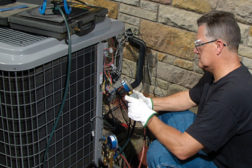Home » alternative refrigerants
Articles Tagged with ''alternative refrigerants''
AHRI Hosts Low-GWP AREP Conference
Program Will Evaluate Promising Alternative Refrigerants for Major Product Categories
July 29, 2013
July 26, 2013: Conference to Present Low-GWP Refrigerant Research Results
Purpose of Research Is to Identify and Evaluate Promising Alternative Refrigerants
July 26, 2013
Mixing R-22 with Other Refrigerants Can Create a Mess
New Refrigerants Require Careful Use
Read More
July 2, 2013: EPA Warns Against Use of Propane as R-22 Substitute
Unapproved Propane-Containing Refrigerants Pose Fire and Explosion Risk
July 2, 2013
June 24, 2013: SAE’s Final R-1234yf Safety Research Says Risk Is Minimal
R-1234yf Refrigerant Is Determined to be Safe to Use
June 24, 2013
Copyright ©2024. All Rights Reserved BNP Media.
Design, CMS, Hosting & Web Development :: ePublishing







